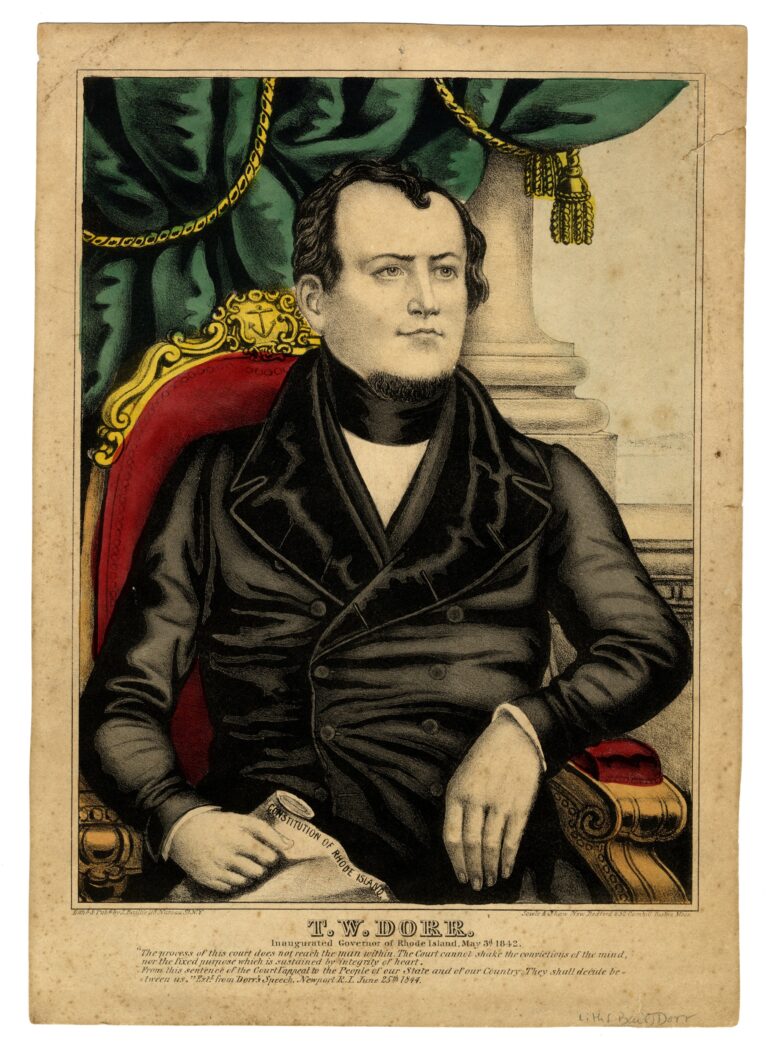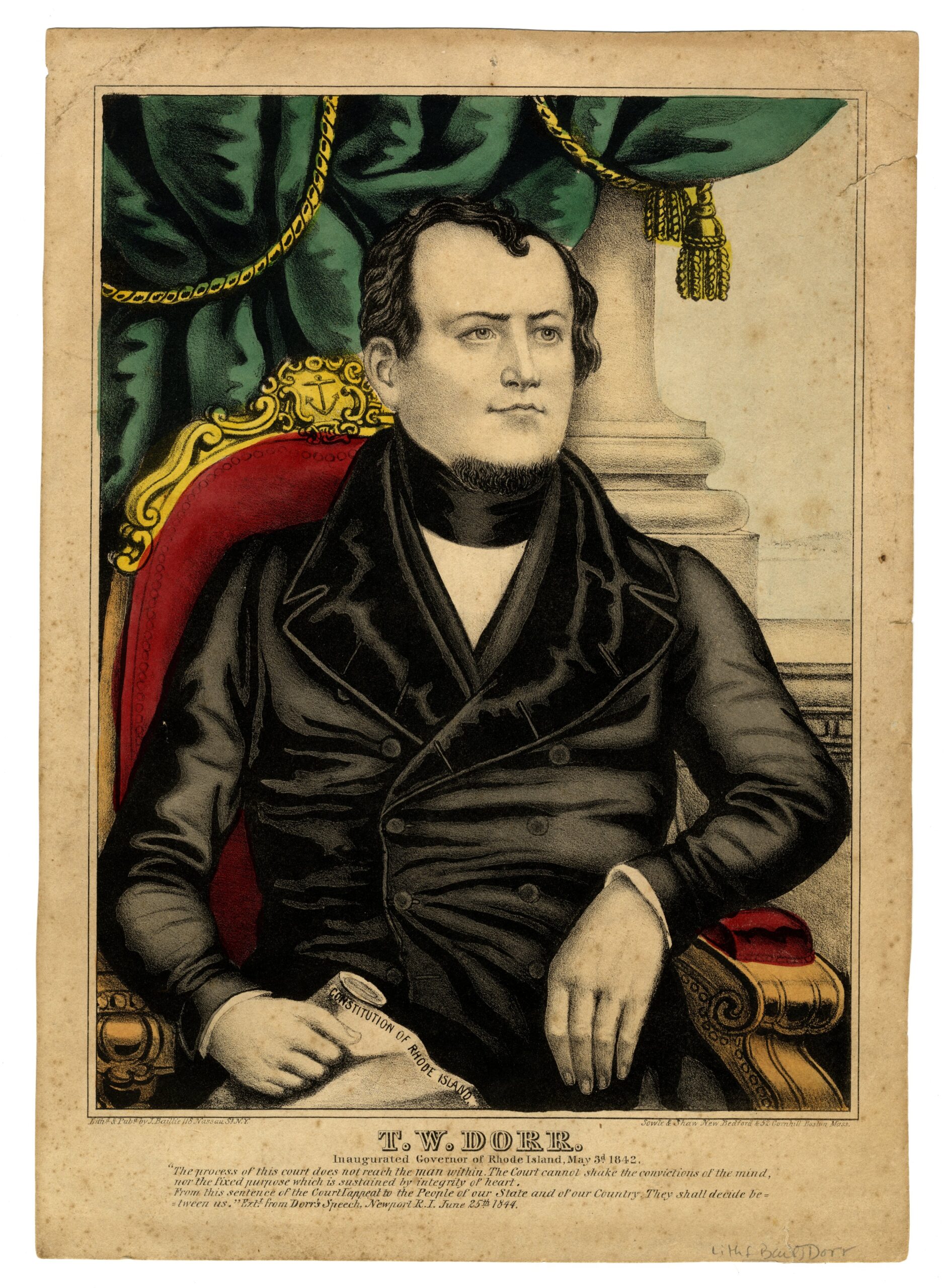The Dorr Rebellion Website

More than two centuries into our national experiment, it is still a vexing question: What is popular sovereignty? Who are “the people” and how can they exercise their sovereign will? What recourse exists for those disenfranchised by race, gender, ethnicity, religion, property, or residence restrictions? What happens when the existing government does not fulfill the people’s will? Thomas Jefferson famously championed—and most states affirmed in their constitutions—the right of the people “to alter or abolish” government that fails to meet their needs. Do, then, the people yet retain the right of revolution?
Popular insurgencies in the early republic brought these questions to the fore. In the 1840s, they brought the people of Rhode Island to blows—literally and dramatically. That episode—the Dorr Rebellion—is a centerpiece of Rhode Island history, but strangely unacknowledged outside the region. It should be. And now a Website sponsored by Providence College and Digital Publishing Services, authored principally by Erik Chaput and Russell DeSimone, makes it possible to delve deeply into this extraordinary popular insurgency and plumb its national implications for the meaning of popular sovereignty.
First, the drama. Rhode Island’s pre-Revolutionary charter restricted suffrage to property owners. When the colony was agricultural and maritime, this requirement was not onerous; more than three quarters of white males were enfranchised freemen in 1775. But over the next fifty years, Rhode Island’s urban, commercial and early industrial growth boomed, creating a large population of landless working men—the majority of whom could not vote. By the 1820s, the politically impotent began to grumble; by the 1830s they had organized to seek suffrage reforms. But they made no headway: power lay in the hands of a landed minority of conservative rural freeholders who adamantly refused change. Reformers grew increasingly frustrated. Then the insurgent populism of the 1840 Log Cabin presidential campaign suggested a new tack.
Thomas Dorr, idealistic scion of a wealthy Providence merchant, took the helm of the Rhode Island Suffrage Association with a revolutionary proposal. In cases of tyranny, he claimed, the people themselves have the authority to form government—without the consent of the existing powers. Emulating the words and methods of the founders, Dorr and his followers issued a general call for an extra-legal “People’s Convention” to draft a new state constitution and institute a new government, overturning the existing authority.

Dorr’s populist rhetoric engaged the disenfranchised. His reasoned legalism drew supporters among some professional and commercial reformers. And his anti-Whig stance appealed to Democrats, whose party leadership he then assumed. By the spring of 1841, the campaign had grown to an immense popular movement of mechanics, immigrant laborers, and middle class professionals. That autumn, town representatives met in convention. They drafted a new constitution, which was then ratified by a majority of adult white males. Dorr was elected governor, and in April 1842, he and his supporters paraded into town to seize power from the sitting “Charter” government.
But the Charterites refused to yield. They claimed that once a government was constituted, sovereignty shifted from the people to the constitution; thereafter government could be changed only by the constituted governors. What followed was three months of violence and violent repression, martial law, ugly nativism, national political machinations, and ardent debates over constitutional interpretation. Ultimately Dorr suffered a crushing defeat of his populist government, culminating in the rout and exile of its supporters. While Dorr was sentenced to life in prison, the Charter government drafted a new constitution that met most of the People’s demands.
This dramatic and somewhat bizarre episode provides rich evidence and insights. It has not gone unnoticed by historians: Marvin Gettleman’s Dorr Rebellion (1973) told a tale of class struggle and radicalism. Regional scholars Peter Coleman, Patrick Conley, and George Dennison have mined the economic, political and constitutional aspects of Rhode Island’s struggle. The most recent treatment is Chaput’s biographical The People’s Martyr: Thomas Wilson Dorr and His 1842 Rhode Island Rebellion (2013). But the episode has mostly been relegated to brief notice in regional histories, in part because sources have been difficult to access.
Those barriers have been admirably felled by The Dorr Rebellion Website. The site provides a wealth of primary source documents, images, a well-conceived documentary film, interpretive essays, lesson plans, a bibliography, and links to additional materials. The centerpiece is a selection of sixty letters to, from, or about Dorr. These are provided as scanned images, and then as searchable transcriptions with encoded terms that activate pop-ups to identify persons, places, and organizations mentioned in the letters. This use of digital editing is particularly helpful, easing the sense—so common when reading letters or diaries—that we are entering a long-running soap opera clueless to cast or plot. The pop-ups tell us who’s who, what’s what, and provide Google maps to tell us where’s where. Chaput and DeSimone have organized the letters into two collections. One set presents the People’s Constitution agenda; the second argues for more gradual change and expresses fears of majoritarian tyranny or even mob rule. Together, the letters portray growth, development, and resistance to Dorr’s popular sovereignty movement. They also reveal the passion and drama of people who dared to risk their lives, fortunes, and sacred honor for the cause.
Educators will appreciate rich supporting materials. Each set of letters is prefaced by a brief but insightful essay (“The Road to Rebellion” is particularly well crafted). A section contrasting the constitutions produced by the Dorrite and Charter factions allows students to compare the documents by article and topic. A twenty-minute documentary film provides an excellent classroom introduction to the controversy. A large gallery of supplemental images allows teachers and students to view portraits, historic sites, maps, newspapers, broadsides, and political cartoons. Five lesson plans designed for high school and college level students admirably expand the Dorr episode to consider how popular sovereignty was refracted through the lenses of gender and race. The role of abolitionism, popular partisan politics, and sectional tensions in influencing national—and federal—responses to the crisis are particularly well presented, as is the interplay of other reform movements. Links to articles by scholars enrich and expand the lessons, detailing how the Dorr crisis rippled across the nation and prompted responses from Missouri to Maine, from New York Loco Focos to terrified Southern Democrats, from Equal Rights women to ardent abolitionists.
This is a rich Website and good model for using digital editing to make primary sources accessible in the classroom. There are a few minor glitches such as inactive links or encoded terms. But the beauty of the digital resource is the ease of editing. The site could be further enriched by links to contemporary assessments such as the “The Nine Lawyers’ Opinion,” (1842), William Goodell’s “The Rights and Wrongs of Rhode Island,” (1842), Francis Bowen’s “The Recent Contest in Rhode Island” (1844), Frances H. Wright’s “Might and Right” (1844), and Burke’s Report (1844). But it is hard to fault a site as rich as this for not having more.
The Dorr Rebellion digital project provides compelling evidence that Rhode Island’s drama deserves a prominent place among case studies of popular sovereignty. Far from being a parochial matter of local history, it is a complex and nuanced instance of the struggle to advance equal rights, a story of national significance—and resonance—in today’s classroom.
This article originally appeared in Fall 2014.
Mary Babson Fuhrer is a public historian and independent scholar who specializes in the social history of colonial and early republic New England. Her book, Crisis of Community: The Trials and Transformation of a New England Town 1815-1848, was recently published by the University of North Carolina Press.
